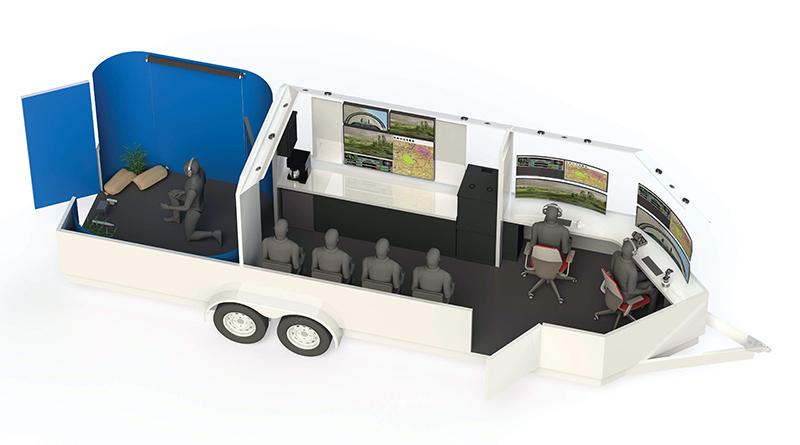New JTAC Training System Could Help Reduce Reliance On Live Range Exercises

A diagrammatic representation of how the new training system (simulator, left; briefing/viewing station, center; trainer workstations, right) is integrated onto a trailer.
A new, portable, immersive and unprecedentedly realistic simulator, launched this month ahead of delivery to its first customer, could help militaries worldwide to streamline and enhance the provision of close air support (CAS) training.
The system has been developed by the British companies Allen-Vanguard, best known for its solutions to defeat RF (radio frequency) threats, and joint-fires support and training specialist Hyperion Defence Solutions. It combines mixed-, augmented- and virtual-reality technologies with trainee and trainer workstations and a briefing/debriefing suite, all installed in a trailer. The launch customer's system incorporates Finnish firm Varjo's XR-4 Focal Edition headset, but the 3D simulations can also be displayed on curved screens - whether mobile or in fixed training centers - or domes.
CAS missions rely on JTACs - Joint Terminal Attack Controllers; often referred to as Forward Air Controllers. These are personnel deployed on the ground who have been trained and qualified to request and direct the deployment of munitions from aircraft. Qualification requirements for JTACs are stringent, and the skills are perishable: so extensive qualification training, and ongoing refreshes, are necessary.
Historically, JTAC training has required significant time spent on bombing ranges, where JTACs communicate directly with aircraft overhead that may then release either inert or live weapons. As well as being expensive, the operational relevance of this kind of training is often limited.
The Joint Fires Support Executive Committee (JFS ESC), the U.S. body which sets and maintains JTAC training and operational standards, accredits training systems for its member nations and its protocols mandate some on-range training. As simulator technology has advanced, the proportion of training JFS ESC says can be conducted in simulators has increased.
"This not only saves significant money versus using live assets, but can often generate more realistic training since there are no real-time restrictions," Hyperion co-founder Chris Derbyshire, a former British Army battery commander and joint-fires senior instructor at the Royal School of Artillery, tells AWST via email. "In addition, trainees can learn from simulated, potentially catastrophic, errors which wouldn’t occur in real training."
Similarly, there are some airborne capabilities which cannot routinely be deployed during live training for other reasons. Electronic-warfare systems, for example, are generally difficult to use on ranges because jamming technologies could interfere with nearby civilian infrastructure. These, and other, effects may be classified, and using them during live exercises would risk disclosing them to adversaries.
The Hyperion/Allen-Vanguard system differs from rival JTAC training solutions by integrating software packages from Sarasota, FL, -based Battlespace Simulation Inc. (BSI) which, Derbyshire says, offer a significant enhancement to the immersiveness and the operational utility of the training the simulations are able to provide. MACE - Modern Air Combat Environment - creates and manages terrain and computer-generated forces (CGF) in the simulation; it is also the tool that trainers use to write and edit training scenarios. ARMOR - Augmented Reality Mission Observation and Rehearsal - is an image generation (IG) tool that enables users to build terrain in the simulation that accurately represents real areas anywhere in the world.
"This provides the end user with total flexibility to train when and where they want," Derbyshire says. "Using the same software provider for the CGF and IG also reduces the integration issues faced when upgrades are installed. Most systems employ separate CGF and IGs which often creates issues when the two software providers work on different development cycles."
The system has been designed to provide an experience that will have value to all trainees that goes beyond their own individual time in the simulation. Small groups of trainees are briefed together, then carry out missions individually in the simulator. The other trainees are able to observe each mission from the briefing suite. The sessions are recorded, using BSI's DIScord software, and are analyzed by the group, and their trainers, in an after-action review.
The consortium has not disclosed the identity of the launch customer, but has confirmed that they are from the Middle East. Derbyshire says the solution "would satisfy any JTAC signatory nation who requires a mobile simulation system," the only likely changes from customer to customer being integration of any specific pieces of military equipment that may need to be included in the simulation environment and scenarios. Accreditation from JFS ESC for the MACE/ARMOR combination has not yet been confirmed but the consortium expects the system to be "amongst the first to achieve" this.


